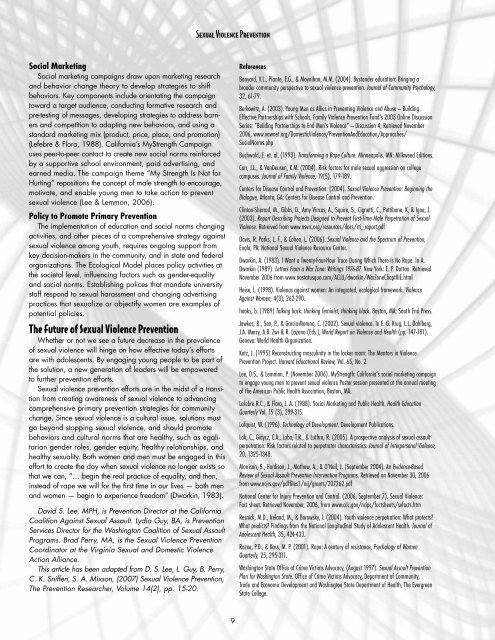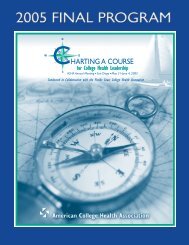Primary Prevention of Sexual Violence - American College Health ...
Primary Prevention of Sexual Violence - American College Health ...
Primary Prevention of Sexual Violence - American College Health ...
- No tags were found...
You also want an ePaper? Increase the reach of your titles
YUMPU automatically turns print PDFs into web optimized ePapers that Google loves.
<strong>Sexual</strong> <strong>Violence</strong> <strong>Prevention</strong>Social MarketingSocial marketing campaigns draw upon marketing researchand behavior change theory to develop strategies to shiftbehaviors. Key components include orientating the campaigntoward a target audience, conducting formative research andpre-testing <strong>of</strong> messages, developing strategies to address barriersand competition to adapting new behaviors, and using astandard marketing mix (product, price, place, and promotion)(Lefebre & Flora, 1988). California’s MyStrength Campaignuses peer-to-peer contact to create new social norms reinforcedby a supportive school environment, paid advertising, andearned media. The campaign theme “My Strength Is Not forHurting” repositions the concept <strong>of</strong> male strength to encourage,motivate, and enable young men to take action to preventsexual violence (Lee & Lemmon, 2006).Policy to Promote <strong>Primary</strong> <strong>Prevention</strong>The implementation <strong>of</strong> education and social norms changingactivities, and other pieces <strong>of</strong> a comprehensive strategy againstsexual violence among youth, requires ongoing support fromkey decision-makers in the community, and in state and federalorganizations. The Ecological Model places policy activities atthe societal level, influencing factors such as gender-equalityand social norms. Establishing polices that mandate universitystaff respond to sexual harassment and changing advertisingpractices that sexualize or objectify women are examples <strong>of</strong>potential policies.The Future <strong>of</strong> <strong>Sexual</strong> <strong>Violence</strong> <strong>Prevention</strong>Whether or not we see a future decrease in the prevalence<strong>of</strong> sexual violence will hinge on how effective today’s effortsare with adolescents. By engaging young people to be part <strong>of</strong>the solution, a new generation <strong>of</strong> leaders will be empoweredto further prevention efforts.<strong>Sexual</strong> violence prevention efforts are in the midst <strong>of</strong> a transitionfrom creating awareness <strong>of</strong> sexual violence to advancingcomprehensive primary prevention strategies for communitychange. Since sexual violence is a cultural issue, solutions mustgo beyond stopping sexual violence, and should promotebehaviors and cultural norms that are healthy, such as egalitariangender roles, gender equity, healthy relationships, andhealthy sexuality. Both women and men must be engaged in thiseffort to create the day when sexual violence no longer exists sothat we can, “… begin the real practice <strong>of</strong> equality, and then,instead <strong>of</strong> rape we will for the first time in our lives — both menand women — begin to experience freedom” (Dworkin, 1983).David S. Lee, MPH, is <strong>Prevention</strong> Director at the CaliforniaCoalition Against <strong>Sexual</strong> Assault. Lydia Guy, BA, is <strong>Prevention</strong>Services Director for the Washington Coalition <strong>of</strong> <strong>Sexual</strong> AssaultPrograms. Brad Perry, MA, is the <strong>Sexual</strong> <strong>Violence</strong> <strong>Prevention</strong>Coordinator at the Virginia <strong>Sexual</strong> and Domestic <strong>Violence</strong>Action Alliance.This article has been adapted from D. S. Lee, L. Guy, B. Perry,C. K. Sniffen, S. A. Mixson, (2007) <strong>Sexual</strong> <strong>Violence</strong> <strong>Prevention</strong>,The <strong>Prevention</strong> Researcher, Volume 14(2), pp. 15-20.ReferencesBanyard, V.L., Plante, E.G., & Moynihan, M.M. (2004). Bystander education: Bringing abroader community perspective to sexual violence prevention. Journal <strong>of</strong> Community Psychology,32, 61-79.Berkowitz, A. (2003). Young Men as Allies in Preventing <strong>Violence</strong> and Abuse — BuildingEffective Partnerships with Schools, Family <strong>Violence</strong> <strong>Prevention</strong> Fund’s 2003 Online DiscussionSeries: “Building Partnerships to End Men’s <strong>Violence</strong>” — Discussion 4, Retrieved November2006, www.vawnet.org/Domestic<strong>Violence</strong>/<strong>Prevention</strong>AndEducation/Approaches/SocialNorms.phpBuchwald, E. et. al. (1993). Transforming a Rape Culture. Minneapolis, MN: Milkweed Editions.Carr, J.L., & VanDeusen, K.M. (2004). Risk factors for male sexual aggression on collegecampuses. Journal <strong>of</strong> Family <strong>Violence</strong>, 19(5), 179-189.Centers for Disease Control and <strong>Prevention</strong>. (2004). <strong>Sexual</strong> <strong>Violence</strong> <strong>Prevention</strong>: Beginning theDialogue, Atlanta, GA: Centers for Disease Control and <strong>Prevention</strong>.Clinton-Sherrod, M., Gibbs, D., Amy Vincus, A., Squire, S., Cignetti, C., Pettibone, K, & Igoe, J.(2003). Report Describing Projects Designed to Prevent First-Time Male Perpetration <strong>of</strong> <strong>Sexual</strong><strong>Violence</strong>. Retreived from www.nsvrc.org/resources/docs/rti_report.pdfDavis, R. Parks, L. F., & Cohen, L. (2006). <strong>Sexual</strong> <strong>Violence</strong> and the Spectrum <strong>of</strong> <strong>Prevention</strong>,Enola, PA: National <strong>Sexual</strong> <strong>Violence</strong> Resource Center.Dworkin, A. (1983). I Want a Twenty-Four-Hour Truce During Which There Is No Rape. In A.Dworkin (1989) Letters From a War Zone: Writings 1976-87. New York: E. P. Dutton. RetrievedNovember 2006 from www.nostatusquo.com/ACLU/dworkin/WarZoneChaptIIIE.htmlHeise, L. (1998). <strong>Violence</strong> against women: An integrated, ecological framework. <strong>Violence</strong>Against Women, 4(3), 262-290.hooks, b. (1989) Talking back: thinking feminist, thinking black. Boston, MA: South End Press.Jewkes, R., Sen, P., & Garcia-Moreno, C. (2002). <strong>Sexual</strong> violence. In E. G. Krug, L.L. Dahlberg,J.A. Mercy, A.B. Zwi & R. Lozano (Eds.), World Report on <strong>Violence</strong> and <strong>Health</strong> (pp. 147-181).Geneva: World <strong>Health</strong> Organization.Katz, J. (1995) Reconstructing masculinity in the locker room: The Mentors in <strong>Violence</strong><strong>Prevention</strong> Project. Harvard Educational Review, Vol. 65, No. 2.Lee, D.S., & Lemmon, P. (November 2006). MyStrength: California’s social marketing campaignto engage young men to prevent sexual violence Poster session presented at the annual meeting<strong>of</strong> the <strong>American</strong> Public <strong>Health</strong> Association, Boston, MA.Lefebre R.C., & Flora, J. A. (1988). Social Marketing and Public <strong>Health</strong>. <strong>Health</strong> EducationQuarterly Vol. 15 (3), 299-315.L<strong>of</strong>quist, W. (1996). Technology <strong>of</strong> Development. Development Publications.Loh, C., Gidycz, C.A., Lobo, T.R., & Luthra, R. (2005). A prospective analysis <strong>of</strong> sexual assaultperpetration: Risk factors related to perpetrator characteristics. Journal <strong>of</strong> Interpersonal <strong>Violence</strong>,20, 1325-1348.Morrison, S., Hardison, J., Mathew, A., & O’Neil, J. (September 2004). An Evidence-BasedReview <strong>of</strong> <strong>Sexual</strong> Assault Preventive Intervention Programs. Retrieved on November 30, 2006from www.ncjrs.gov/pdffiles1/nij/grants/207262.pdfNational Center for Injury <strong>Prevention</strong> and Control. (2006, September 7). <strong>Sexual</strong> <strong>Violence</strong>:Fact sheet. Retrieved November, 2006, from www.cdc.gov/ncipc/factsheets/svfacts.htmResnick, M.D., Ireland, M., & Borowsky, I. (2004). Youth violence perpetration: What protects?What predicts? Findings from the National Longitudinal Study <strong>of</strong> Adolescent <strong>Health</strong>. Journal <strong>of</strong>Adolescent <strong>Health</strong>, 35, 424-433.Rozee, P.D., & Koss, M. P. (2001). Rape: A century <strong>of</strong> resistance, Psychology <strong>of</strong> WomenQuarterly, 25, 295-311.Washington State Office <strong>of</strong> Crime Victims Advocacy, (August 1997). <strong>Sexual</strong> Assault <strong>Prevention</strong>Plan for Washington State. Office <strong>of</strong> Crime Victims Advocacy, Department <strong>of</strong> Community,Trade and Economic Development and Washington State Department <strong>of</strong> <strong>Health</strong>, The EvergreenState <strong>College</strong>.9



![Final Program [5.4MB pdf] - American College Health Association](https://img.yumpu.com/49022356/1/190x245/final-program-54mb-pdf-american-college-health-association.jpg?quality=85)












